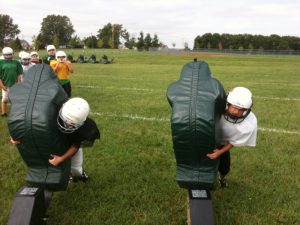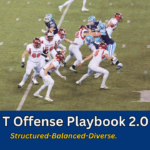Youth Football Online
The Promotion & Instruction of Youth Football
0 items
-$0.00
Home / Football Speed and Agility Training
Youth football speed and agility questions answered by Dr. Katarina Erlandsson PT, DPT:
How do you improve young athletes’ sprint speed while avoiding injury & overtraining?
As a coach you probably have your favorite speed drills that you take your athletes through during training. Accelerating into a sprint, decelerating suddenly, and changing directions quickly, are all high intensity loading activities that are crucial for our young athletes to master.
But speed drills are not the only ways to improve how fast your athletes can take off and accelerate. Recent research concludes that there is a significant transference of strength training to gains in other performance skills, such as sprint speed. Studies on elite youth soccer players, for example, have shown that gains in back-squat strength also improved speed and agility significantly more than in control training groups (also elite youth soccer players) who were not involved in that strength training program.
In other words, even though regular speed drills work well for improving quickness (as it is a specific form of training), strength training gives young athletes that extra opportunity to reach even higher velocities, faster. But wait – there’s more! Strength training has also been deemed to help reduce injury risk while producing great health benefits. And, with proper supervision, it is a safe form of exercise. It’s a win-win situation.
Here are a few things to keep in mind when developing a good strength training program for youth athletes:
A mastery of fundamental movement skills is crucial for our younger children before adding on dumbbells and other external resistance tools. Bodyweight strength training therefore tends to be a great opportunity to not only improve strength, but to also teach motor skills in a safe manner.
For this age group, a plyometric training-only program has been proven to improve sprint speed according to a study that measured acceleration speed changes in 10-meter sprints. But there were even greater gains in sprint speed among the children who did plyometrics combined with a strength training program. As long as these athletes are moving properly, we can progress bodyweight strength training to external loading with resistance bands, medicine balls and dumbbells.
An appropriate training program for prepubescent athletes should include a combination of plyometrics and some strength training, primarily bodyweight resistance training.
Programs can include:
See speed and agility drills for football that can be done at home:
Strength gains and muscle mass increases are a normal part of development and growth for adolescents, particularly among boys. These musculoskeletal changes tend to quite naturally result in faster sprint speeds among athletes. However, several studies have shown that adolescent athletes that also participated in heavy resistance training, recorded remarkable improvements in acceleration velocity compared to those who did not lift heavy. It is important to take advantage of this time frame of development and challenge our athletes with heavier weights. This is beneficial not only for performance gains, but also for developing strong healthy bones. Optimizing bone strength and density during adolescence will have a positive effect on our athletes’ future musculoskeletal health.
It is also worth noting that, unlike their younger counterparts, plyometric training alone did not produce faster sprint speeds among adolescents. Strength training alone, however, did. But again, a combination of resistance and plyometric training gave the best results overall.
A strength training program that yields speed improvements for adolescent athletes should include heavy resistance training, with some plyometrics. Resisted sports specific drills are important as well – these also tend to be more effective when loaded up with heavy resistance, versus light or moderate resistance.
Programs can include:
Optimal heavy loading prescription:
Intensity: 80-89 1RM
Set / Reps: 5 x 6-8
Rest between sets: 3-4 minutes
2-3 times a week, depending on exercise response.

Sled pulling has traditionally been done with “light” to “moderate” resistance as to not affect sprinting technique. But recent studies suggest that any compromise in sprinting form during resistance sprint training, does not seem to transfer to regular free sprinting. If you’re looking to get the most out of these drills, loading up heavy is again the most effective way to accomplish this task.
For example, an athlete doing sprint drills with no resistance, had similar percentage improvements in speed as athletes who loaded up a sled with light weight (corresponding to 36% of their body weight). If we increase the sled load to “heavy” (96% of the athlete’s body weight), athletes saw their sprint speed percentage improve to almost double of that performed with a light weight load.
Proper supervision from coaches or other professionals is key in keeping these exercises safe and beneficial for adolescents. In fact, strength training is deemed to have a very low injury risk when executed well. Proper technique and appropriate progression of load make all the difference. Give the athlete feedback on form when they’re lifting, and plan out how much to increase the weight based on completion of sets and reps with proper form (an increase in load should not be a pure guessing game).
Finding that good form when moving on to heavier weights during adolescence, can actually be quite easy if fundamental movement skills and basic bodyweight exercises were emphasized early on in a child’s training program. Incorporating focused movement training for our athletes at a young age simply pays off in the long run.
Finally, allow for rest days within the training program. How much rest should we schedule? Well, it depends. Start with more rest than you’d think the athletes need. Recovery time is often underrated as a training tool. But recovery and rest/sleep are incredibly important in reducing injury risk, as well as improving performance. Turns out that recovery, too, is a win-win situation.
Dr. Katarina Erlandsson PT, DPT
Board Certified Orthopedic Clinical Specialist, Physical Therapist specializing in the management of injuries among runners of all levels.
Dr. Erlandsson practices in Madison, NJ and surrounding areas, visit her site www.katarinapt.com

Want to contribute content? Contact us if you are interested in contributing content.
All children will learn life lessons from participating in youth football. Join our Movement today.
* indicates required

Copyright ©2023 Youth Football Online. All rights reserved.